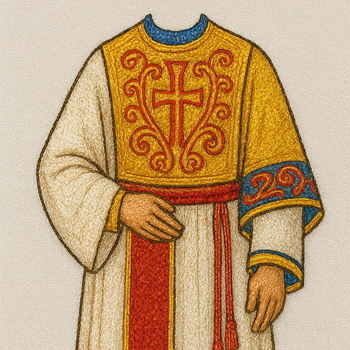Receive God's Love, Proclaim the Greatness of the Lord, Serve Joyfully & Make Missionary Disciples of Jesus Christ
-

As clergy prepare for Mass, the vesting process is accompanied by solemn actions and prayers. These sacred moments help the deacon prepare himself to serve at the altar of Christ. The deacon—through baptism and ordination—is set apart for the ministry of service in Word, altar, and charity.
The deacon first dons the alb, that long white garment common to all ordained ministers and altar servers. It recalls the baptismal garment, symbolizing purity and new life in Christ. Secured by the cincture, it prepares the deacon for humble service and reminds him of the call to chastity and self-discipline.
The stole, however, is worn differently by a deacon than by a priest. Instead of draping it around both shoulders, the deacon wears it across the chest, from the left shoulder to the right side. This diagonal placement symbolizes his distinct role of service rather than presiding. The prayer associated with the stole emphasizes joy in serving Christ: “O Lord, endow me with the garment of salvation, the stole of gladness; may I always find delight in serving at Your holy altar.” Its liturgical color matches the celebration of the day.
The dalmatic is the vestment proper to the deacon and is worn over the alb and stole. Shaped like a wide-sleeved tunic, it traces its roots to the garments of the early Church and the attire of Roman officials. Symbolically, the dalmatic represents joy and charity. Its broad sleeves are often seen as an image of generous service, the open arms of Christ reaching to those in need. Its prayer expresses this connection: “Clothe me, O Lord, in the garment of salvation, the vestment of joy, that I may worthily minister at Thy altar.” Rich in color and decoration, the dalmatic highlights the dignity of the diaconate while distinguishing it from the priestly chasuble.
Together, these vestments remind the deacon of his threefold ministry: to proclaim the Gospel, to serve at the altar, and to embody Christ’s charity among the people of God. In vesting, the deacon prays not only to be properly clothed for liturgical service but to be inwardly conformed to Christ the Servant.
Next week we will explore the vestments and tools unique to Bishops.
RINCÓN DE LITURGIA
Vestimentas de diáconoAl prepararse el clero para la Misa, el proceso de revestirse se acompaña de acciones y oraciones solemnes. Estos momentos sagrados ayudan al diácono a disponerse para servir en el altar de Cristo. El diácono—por el bautismo y la ordenación—es apartado para el ministerio de servicio en la Palabra, el altar y la caridad.
El diácono se pone primero el alba, esa larga vestidura blanca común a todos los ministros ordenados y a los monaguillos. Recuerda la vestidura bautismal, simbolizando la pureza y la vida nueva en Cristo. Ceñida con el cíngulo, prepara al diácono para el servicio humilde y le recuerda el llamado a la castidad y la autodisciplina.
La estola, sin embargo, se usa de manera distinta en el diácono que en el sacerdote. En lugar de llevarla colgada sobre ambos hombros, el diácono la coloca en diagonal, desde el hombro izquierdo hasta el costado derecho. Esta disposición simboliza su papel propio de servicio más que de presidencia. La oración asociada con la estola enfatiza la alegría de servir a Cristo: “Señor, revísteme con la vestidura de salvación, con la estola de alegría; que siempre encuentre gozo en servir en tu santo altar.” Su color litúrgico corresponde a la celebración del día.
La dalmática es la vestidura propia del diácono y se lleva sobre el alba y la estola. Con forma de túnica de mangas anchas, sus raíces se remontan a las vestiduras de la Iglesia primitiva y a la indumentaria de los funcionarios romanos. Simbólicamente, la dalmática representa la alegría y la caridad. Sus mangas amplias suelen verse como imagen del servicio generoso, los brazos abiertos de Cristo que se extienden hacia quienes necesitan. Su oración expresa esta conexión: “Revísteme, Señor, con la vestidura de salvación, con el ornamento de la alegría, para que pueda servir dignamente en tu altar.” Rica en color y decoración, la dalmática resalta la dignidad del diaconado al mismo tiempo que lo distingue de la casulla sacerdotal.
En conjunto, estas vestiduras recuerdan al diácono su triple ministerio: proclamar el Evangelio, servir en el altar y encarnar la caridad de Cristo en medio del pueblo de Dios. Al revestirse, el diácono ora no solo para estar adecuadamente dispuesto al servicio litúrgico, sino también para configurarse interiormente con Cristo Siervo.
La próxima semana exploraremos las vestiduras y los ornamentos propios de los Obispos.
